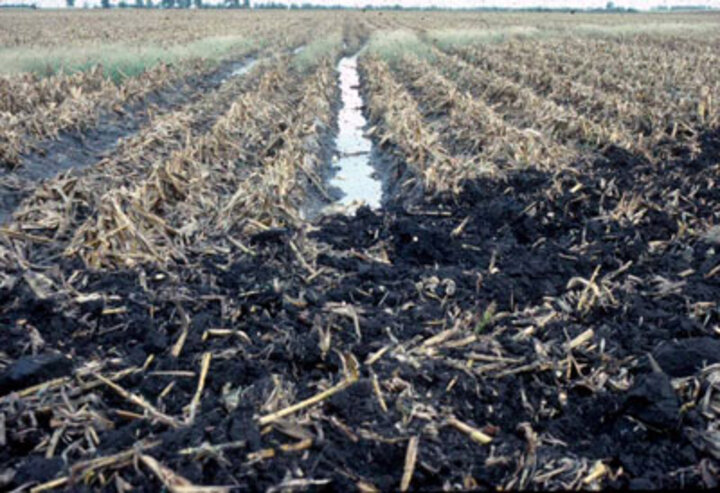April 2, 2010
With the late snow melt and early spring rains, many producers are waiting to start their tillage and planting. Others are going to the field early and tilling to dry out the soil so that they can plant; however, tilling a wet soil causes compaction and should not be done. Driving on or tilling wet soil is the primary cause of compaction. Instead, wait a day or two for the soil to dry some or consider skipping the tillage completely by no-tilling.
|

Figure 1. Wheel traffic compaction cannot be eliminated with tillage if the soil is wet as the tillage itself creates more compaction. If ruts are in the field, use shallow spring tillage just to smooth the surface in the problem areas. |
When tilling wet soil, the excessive moisture lubricates the soil particles, allowing them to "slide" under the weight of the tractor and tillage implement, creating compaction across the full width. The same is true when driving on wet soils, but the compaction will be only in the wheel tracks, often appearing as a rut. This destroys soil structure, squeezes the air spaces out of the soil, and reduces the pore spaces available for water storage. This also reduces the infiltration rate of the soil which actually makes wet spots in the field larger with the next rain. The weight of the tractor and implement are supported by the soil below the tillage layer, forming a tillage pan. When the compaction is severe, this pan reduces root penetration and can affect yields.
By staying off wet soils and using no-till, the natural soil structure can build with wetting/drying and freezing/thawing cycles forming vertical cracks in the soil. Infiltration improves over time and the wet spots heal themselves. Many no-tillers and ridge-tillers have reported this after several years of not tilling the soils. In addition, many have seen that as the natural soil structure builds, the fields are firmer and they can actually get into them sooner after a rain. Compaction is further reduced with no-till as the planter and the tractor pulling it are usually quite a bit lighter than tillage implements and the larger tractors required to pull them.
With the improved structure, ruts at harvest also become less of a problem. Typically, ruts are as deep as the tillage because the soil has very little structure in the tillage layer and the tires cut down through to the compacted soil of the tillage pan. Tilling deeper than the tillage pan can open up the soil, but it also destroys soil structure, making the soil more susceptible to compaction with the next pass in the field. This fracturing can only occur with dry soils normally found with fall tillage and should not be attempted in the spring. Care must be taken with subsequent field operations to avoid recompacting the soil.
If ruts were created at harvest or during an early spring field operation, a shallow tillage operation may be needed to smooth the field. Again, if the soil is wet, you cannot fracture the compaction in the ruts and you actually risk causing more compaction the deeper you till. Shallow spot tillage in the problem areas reduces the chances of causing more compaction.
Paul Jasa
Extension Engineer
